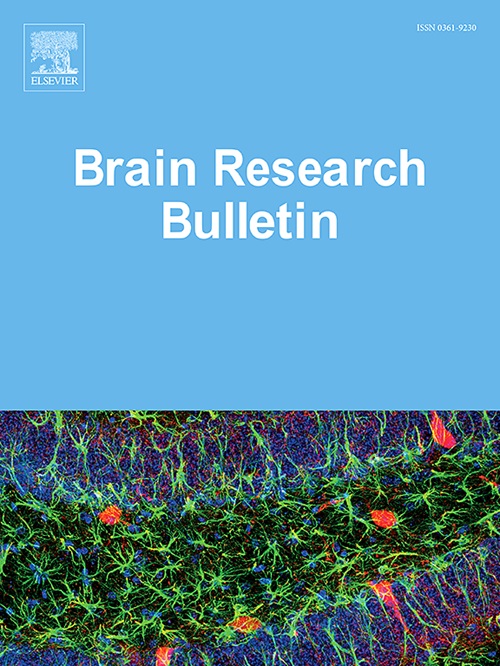Environmental enrichment attenuates social isolation-exacerbated postoperative cognitive dysfunction in aged mice via inhibition of RAGE-HMGB1 proinflammatory signaling
IF 3.5
3区 医学
Q2 NEUROSCIENCES
引用次数: 0
Abstract
Microglial overactivation, leading to neuroinflammation, plays a pivotal role in the development of postoperative cognitive dysfunction (POCD). However, the reasons behind varying inflammatory and cognitive reactions to similar surgical stresses among individuals remain enigmatic. Social isolation (SI), a prevalent psychosocial stressor among older adults, is known to intensify neuroinflammatory reactions and may represent a crucial but overlooked risk factor for POCD. Utilizing aged mouse models, our study reveals that four weeks of preoperative SI considerably worsens surgical-related cognitive deficits, specifically affecting spatial memory (evident from increased Barnes maze latency) and recognition memory (manifested by decreased novel object preference). From a mechanistic perspective, SI predominantly boosts HMGB1-RAGE signaling (rather than TLR4), leading to M1 microglial activation (marked by elevated iNOS and CD86 levels), synaptic destabilization (indicated by decreased PSD95 and SYN), and elevated proinflammatory cytokines. Genetic downregulation of RAGE reverses these alterations, whereas environmental enrichment (EE) offers neuroprotective effects by specifically blocking the RAGE–HMGB1 pathway. Notably, RAGE overexpression negates the beneficial effects of EE, emphasizing the key role of this receptor in SI-induced susceptibility to POCD. Our findings experimentally demonstrate that SI predisposes individuals to POCD via RAGE-dependent neuroinflammatory priming and suggest EE as a potential targeted intervention. These results could inform tailored preventative measures for elderly surgical patients at risk.
环境富集通过抑制RAGE-HMGB1促炎信号,减轻社会隔离加重的老年小鼠术后认知功能障碍。
小胶质细胞过度激活,导致神经炎症,在术后认知功能障碍(POCD)的发展中起着关键作用。然而,个体之间对类似手术压力的不同炎症和认知反应背后的原因仍然是谜。社会隔离(SI)是老年人中普遍存在的社会心理压力源,已知会加剧神经炎症反应,可能是POCD的一个关键但被忽视的风险因素。利用老年小鼠模型,我们的研究表明,术前4周的SI显著恶化了手术相关的认知缺陷,特别是影响空间记忆(明显来自巴恩斯迷宫潜伏期的增加)和识别记忆(表现为对新物体偏好的降低)。从机制角度来看,SI主要促进HMGB1-RAGE信号传导(而不是TLR4),导致M1小胶质细胞激活(以iNOS和CD86水平升高为标志)、突触不稳定(以PSD95和SYN降低为标志)和促炎细胞因子升高。RAGE的遗传下调逆转了这些改变,而环境富集(EE)通过特异性阻断RAGE- hmgb1通路提供神经保护作用。值得注意的是,RAGE过表达否定了EE的有益作用,强调了该受体在si诱导的POCD易感性中的关键作用。我们的研究结果通过实验证明,SI通过rage依赖的神经炎症启动使个体易患POCD,并建议EE作为潜在的靶向干预措施。这些结果可以为有风险的老年外科患者提供量身定制的预防措施。
本文章由计算机程序翻译,如有差异,请以英文原文为准。
求助全文
约1分钟内获得全文
求助全文
来源期刊

Brain Research Bulletin
医学-神经科学
CiteScore
6.90
自引率
2.60%
发文量
253
审稿时长
67 days
期刊介绍:
The Brain Research Bulletin (BRB) aims to publish novel work that advances our knowledge of molecular and cellular mechanisms that underlie neural network properties associated with behavior, cognition and other brain functions during neurodevelopment and in the adult. Although clinical research is out of the Journal''s scope, the BRB also aims to publish translation research that provides insight into biological mechanisms and processes associated with neurodegeneration mechanisms, neurological diseases and neuropsychiatric disorders. The Journal is especially interested in research using novel methodologies, such as optogenetics, multielectrode array recordings and life imaging in wild-type and genetically-modified animal models, with the goal to advance our understanding of how neurons, glia and networks function in vivo.
 求助内容:
求助内容: 应助结果提醒方式:
应助结果提醒方式:


